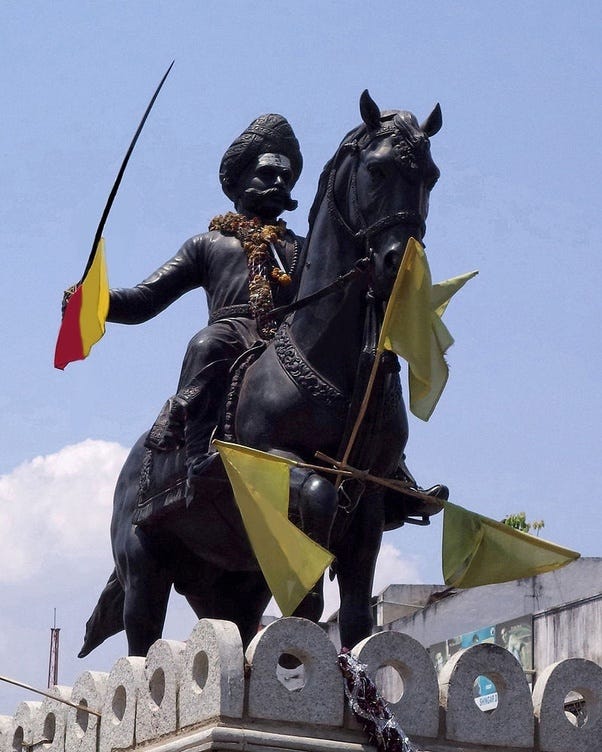Basically, there were three main players, in this scenario, after the death of Sri Ranga III. One was Shivappa Nayaka of Ikkeri, other was Thirumalai Nayak of Madurai and finally Kanteerava Narasaraja of Mysore.
After being overthrown by the Golkonda forces, Sriranga III, spent his last years with Shivappa Nayaka of Ikkeri till he passed away in 1678. Shivappa Nayaka was one of the more notable rulers of the Keladi Nayakas of Shimoga. The Keladi Nayakas were initially vassals of the Vijayanagara Empire, and later with it’s decline, prcolaimed themselves as an independent kingdom. The great Rani Chenamma who repulsed the Mughal Army of Aurangzeb belonged to this dynasty.
Shivappa Nayaka, put a check to the Portuguese, and recaptured the ports of Mangalore, Honnavar, and Kundapura on the West Coast from them. He also conquered a significant part of the Malabar right up to Kasargod, and the forts at Chandragiri, Bekal, Mangalore were built by him. He also recaptured most of the territory in Northern Karnataka from Bijapur Sultanate. As an administrator, he introduced a revenue setttlement scheme called as Sist, by which agricultural lands were divided into five types, and taxation differed by a unit called the Khanduga.
Thirumalai Nayak was one of the great rulers of the Maduri Nayaka kingdom of the 17th century. A patron of art and architecture, he added an additional tower to the Meenakshi temple. And also the beautiful Tirumala Nayaka Mahal, in Madurai, an outstanding representation of Dravidian and Rajput styles combined together.
However on his ascent to the throne, the Vijayanagara Empire by then was in it’s last stages, restricted primarily to Vellore and Chandragiri. The rulers of Mysore, Thanjavur, Gingee and Madurai, began to fight among themselves to take control. At the same time, the Bahmani Sultans began to press down South. Thirumalai by then had broken away from the Vijayanagara Empire, and also persuaded the Nayakas of Thanjavur and Gingee to join him against Sri Ranga III, who only had the support of Mysore. However Thanjavur switched sides, and Thirumalai, asked the Bijapur sultan to assist him, when Ranga laid siege to Gingee.
Pretty much a short sighted decision, as the Bijapur forces, turned on the Nayakas, after defeating Vijayanagara-Mysore, and laid waste to the territory. Gingee was captured by Bijapur forces, who then defeated the Thanjavur Nayakas, and large parts of Maduri, Thanjavur territory were laid waste. Thirumalai had to surrender to Bijapur, pay a large amount of money to the Sultan as tribute.
Again when Sri Ranga III, tried to recapture the territores from Golkonda, in alliance with Shivappa Nayaka and Mysore, Thirumalai once again allied with the Bijapur and Golkonda sultans. This was to settle long standing scores he had with the Mysore ruler. The Golkonda sultan attacked Mysore, defeated it’s ruler and also captured Vellore Fort, ending the Vijayanagara empire effectively. Once again he had to pay large amount as tribute to the Golkonda sultan.
Kantirava Narasaraja was the 12th of the Wodeyar rulers, and he had earlier repulsed an attack on Srirangapatna by the Adil Shahi rulers of Bijapur. He still continued to recognize the Vijayanagara Empire, even though it had totally shrunk to a small territory covering Vellore- Chandragiri. Narasaraja waged a series of wars with Madurai Nayakas, capturing Satyamangala, Coimbator, Salem from them, which he retained till 1800. Periyapatna was conquered from the Chingalvas and also bought to an end the rule of Kempe Gowda. He also created the symbols of royalty for Wodeyars, including it’s coat of arms, established the mint, and issued coins named after him.



